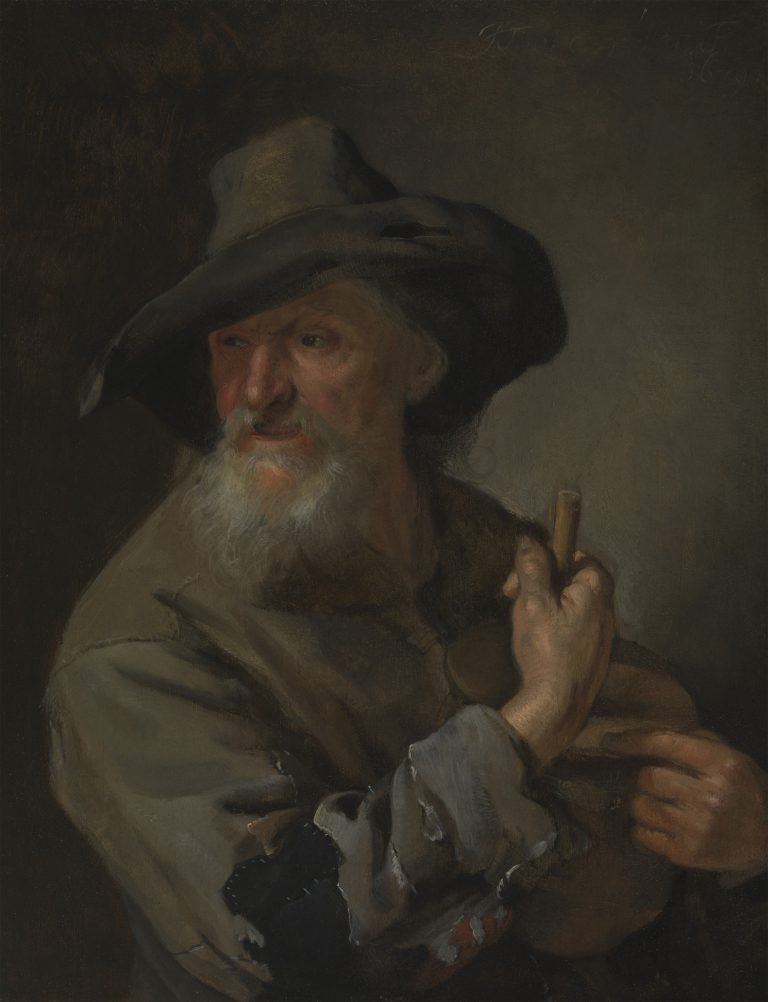Wearing a wide-brimmed hat and tattered clothing with visible patchwork, an old man sings and plays a rommel pot. He turns his head toward the left, in the direction of the light source, as if addressing someone outside the pictorial space. Light illuminates his wrinkled face and gray beard, while subtle shadows along his left shoulder and the brim of his hat silhouette his form against an undefined background. Jacob Toorenvliet painted this lifelike depiction of an old musician in 1679, the year in which he returned to his native Leiden after a long stay in Vienna.1 Whether he painted this small copper panel in Leiden or Vienna, the painting is thematically, compositionally and technically reminiscent of his works from the late 1670s.2 For example, in 1678 he had used a similar bearded model in two comparable half-length depictions of a hurdy-gurdy player.3
The rommel pot was a crude musical instrument made of an earthenware jar covered with a pig’s bladder. The stick that punctures the bladder agitates the air inside, producing sounds that mimic the low grunting of a pig. Though this handmade instrument could be played throughout the year, rommel pot playing was particularly associated with the energetic celebration of Shrove Tuesday (Vastenavond), when children went from door to door singing and dancing in exchange for money or sweets.4 In seventeenth-century paintings and prints of such joyful festivities, the rommel pot player was often accompanied by children or other street musicians. He was often depicted with the attributes of a fool, recalling the folly of Carnival itself, which concludes on Shrove Tuesday. In The Rommel Pot Player (fig 1), attributed to Frans Hals (1582/83–1666), for example, the player, surrounded by a crowd of children, wears a hat with a foxtail, a traditional attribute of the fool.5 A print by Jan van de Velde shows a rommel pot player with a similar hat, and it bears an inscription that reveals his role: “At Shrovetide, many fools walk about / For farthings [they] grunt on a rommel pot.”6
The figure in this picture is depicted neither as a fool nor accompanied by festive children, and thus it is unlikely that Toorenvliet conceived his work within this well-established iconographic tradition. Other traditions, however, did exist for depictions of rommel pot players, and Toorenvliet’s painting may belong to one of those. For example, a print by J. Dubois after J. Matham (fig 2), which depicts a half-length old man playing a rommel pot, makes it quite clear that this musician’s motivation for playing was financial gain: coins lie on the table before him and the inscription on the print reads “I play a fool for the profit from this pot.”7 However, as no coins are seen in Toorenvliet’s painting, it is unlikely that he conceived his work in the same vein. More probable is that this copper panel formed part of a now lost series of the five senses, with this work depicting the sense of hearing. Toorenvliet did, in fact, paint such a series in the late 1670s, in which he depicted the sense of hearing as a man singing and playing the lute.8 The rommel pot would also have been an appropriate attribute for the sense of hearing, perhaps for a group of lower-class personifications of the senses. Whether as an individual painting or part of a series, Toorenvliet’s lively depiction of a rommel pot player still has the power to make the spectator vividly recall the ear-splitting sounds of this folksy instrument.
